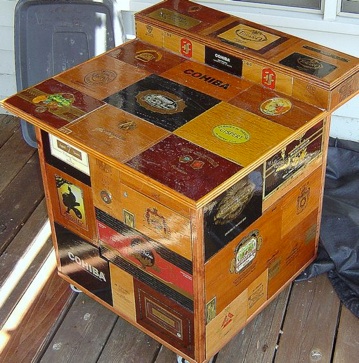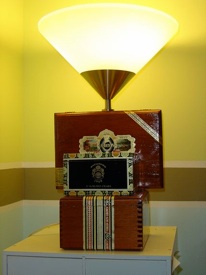Made From Boxes
A National Cigar History Museum Exhibit
Text and images © Tony Hyman, all rights reserved
Last upgraded: October 10, 2012

Made From Boxes
A National Cigar History Museum Exhibit
Text and images © Tony Hyman, all rights reserved
Last upgraded: October 10, 2012
Because cigar box wood was free, found everywhere and easy to work it became the medium of choice for tens of thousands of amateur and professional crafts persons of all ages. I haven’t purchased very many of the items they produced, but what I have obtained and exhibit here will I hope inspire you to investigate the field further.
Cigar band decoupage was particularly popular 1900-1930. This colorfully done example dates around 1905.
The cigar brand is LAS PALMAS made in New York City for a Los Angeles distributor.
[9774]
Automobile license plate from the early days when car owners supplied their own. Painted on the lid of a 1910 DON JUAREZ cigar box.
[9779]
This item is not in the NCM collection.
The cigar box art form most often illustrated was the cigar box musical instrument.
Lavish living commercial magazine and calendar artist Raymond James Stuart, who worked from 1921 to 1962, frequently portrayed boys (usually with dogs) playing cigar box instruments. Stuart was known for his cute kid paintings, tho he once confided to a reporter that he couldn’t stand “the noisy, squirmy little buggers.”
This 1946 Stuart calendar picturing a cigar box violinist was the personalized Christmas card of famous Russian concert violinist David Rubinoff whose autographed picture hangs on the boy’s wall.
[0345]
BELOW: The cigar box collection hanging on an office wall in Hyman’s National Cigar Museum.
MUSICAL CIGAR BOXES
A personal memory
by Tony Hyman
My 1960’s were spent living in Hawaii, California, Colorado, California, Chicago and New York City in that order. During that entire decade I was almost always in class or teaching one (jhi, hs, jr college, college, adult, and Peace Corps) a journey that went from Navy Petty Officer to Columbia University doctoral candidate.
The middle of that decade found me also hosting a weekly radio show, American Folk something or other, on KSJS, the San Jose State College radio station. The show, and previous experience as a Colorado State (Ft. Collins) folk music concert promoter, gave me the opportunity to meet and interview guitarists, black and white, who reminisced about their first instrument, inevitably made from a cigar box by some loving family member.
“What’s this?”
“A child’s toy made from a cigar box,” he said.
“What do you want for it,” I asked.
“Oh...gimme a buck.”
Marilee swears my feet never touched the ground on my way to the car.
In the following thirty years years I located a few dozen guitars, violins, ukes and banjos, as well as a few less familiar creations. They had been made as toys, stage props, department store window decoration and as serious musical instruments, some made by very fine luthiers. I learned that instructions for making cigar box instruments appeared in men’s, women’s and boy’s magazines as early as the 1870’s. (the one illustrated is from Science and Mechanics, 1948) Popular in all generations from the Civil War to Vietnam, cigar box instruments are undergoing a revival of interest today. Bands made up wholly or in part by cigar box instruments now play gigs, record CD’s and highlight festivals. Instruments of all ages sell on eBay.
Recent interest in cigar box music led me to deaccession more than half my collection, giving others the opportunity to play and enjoy them.
I kept only enough to fill an 8 foot wall in my ephemera library. Thanks are due to friends, dealers and strangers who helped find these and other instruments for me, especially US flag collector Mark Sutton, who found 4 of the ones displayed on the wall. That number has since been reduced to only my six favorites.
top to bottom: [9783] [9792] [9782]
from left to right
1] This WWI era violin is the only long-bodied cigar box instrument I’ve seen. Built on a cut-down (made thinner) NW 250 with 1910 tax stamp, this has 4-strings on a factory neck. SOLD
2] Odd 3-string 2-peg varnished violin. All hand made on an 1880-1910 NW 50/13. My first instrument, bought for a buck in the mid 70’s (see story below).
3] Once working 5-string electric guitar in cat motif all hand made for 1960’s junior rocker Kathy on a common 1950’s redwood BROOKS & CO. TEBSON Invincibles BN 50/10 box. Curator’s favorite
4] Built on a Cinco cigar box from 1910-1915, this 4-string violin has a hand-carved neck. SOLD
6] This lovely well sanded and dramatically designed 1-stringer was made by distinguished service medal holder Private Clarence Everingham, killed in battle at age 25 just 37 days before the end of WWI. Clarence was a HS honor student and accomplished strings player, especially known as a mandolinist. That’s his photo. Curator’s favorite
7] Beautifully toned modern ukulele, Model CBU-C, signed by Black Bear in Yakima, Washington. The BN 50/13 CORINA Larks box dates from 1950. The central label and price sticker were originally inside, and have been moved and used as design elements.
8] Another beautifully crafted modern instrument. Built on a common SAM’L DAVIS SBN 50/13 box from the early 1960’s, its graceful Brancusi-like neck, even coloring and
fine sound make this an all-around winner. “It looks like a redwood cigar ukulele I made in the 70’s to save the box from ending up in the trash dump” wrote Honolulu’s master craftsman Sam Kamaka in response to photos. Kamaka is known to have made 12 similar instruments, 7 of which are alleged to be of particularly fine quality. Kamaka’s lovely uke is the only item I bought as a direct result of my three years doing weekly antiques features for CBS-TV Network’s Saturday Early Show. Curator’s favorite
9] Unusual in many construction details, this 4-stringer has a star shaped hole, sturdy metal neck brace that’s all hand made, with nylon strings, based on a standard NW 50/13. SOLD
10] Simple small guitar on an unusual 50/13. 1910-1940. SOLD
11] Violin-style holes ON this 1-stringer built on an NW 50/13 that could be as late as the 1930’s. SOLD
12] Distinctively painted long-necked one stringer with a unique (in my experience) triangular neck brace. NW 50/13 box. SOLD
Terrific cigar box truck with iron wheels, steering that works, and other amenities made during the Great Depression of the 1930’s.
[8856]
I own the PostCard photo, not the cigar box construction. Unfortunately the boxes used give no clue to what the building represented, tho a state capitol is a good guess.
[9780]
Wall mounted kitchen match holder lovingly crafted from cigar boxes, perhaps a special gift for a loved one.
[9777]
Picture frame with elaborate cut.
A lovely piece of patriotic craftsmanship from the WWII era. Carved, glued, and painted, it seems to be based on a mix of standard 1930’s NW 50/13 boxes rebuilt from the ground up.
[8593]
An inventive cigar box recycle is this ice fishing rig built into a common HUMO tin 50/13 box from the 1920s. Includes supports, a crank reel, tackle, storage...
all in one.
[6599]
1920’s radio receiver built into a boite nature
(BN 50/13) cigar box. The box, not the radio, was originally special made for The Hupp Motor Car Corporation as a premium given to customers to celebrate their new car.
[6591]
The radio still works.
Plaster of Paris, gesso, paint, macaroni, beads, sea shells, decoupage ... they were all used to decorate cigar boxes, sometimes all at once.
[6596]
Painted cigar tins aren’t found as often as you might expect. It’s no surprise that painted cans most often date from the tin can era 1910-1940.
[6597]
Covering cigar boxes with decals or cut-up trade cards and calendars has long been popular as well. Most common 1880-1910.
Unusual as it may be, the dark blue and edging appear to be original.
[2567]
Cutting up cigar boxes to make things was popular for 100 years. The wood was nicely grained, easy to cut with a coping saw and available everywhere.
Cigar smokers provided the raw material for furnishing many a doll house.
[6595]
[6592] [6593]
Home theater made in the 1870s from a cigar box and
pictures clipped from popular illustrated weeklies of the day. At one time, this had a top ‘viewing screen.’ Cutting a hole in the lid would severely weaken it, increasing the likelihood of failure. Likelihood won. Lid is now gone but cranks work and the pictures scroll as well as they did when new.
[6594]
Title
On a personal note I must confess to having been given my grandmother’s padded and “tramp art style” decorated cigar box made for her by an uncle in 1884 Germany. When I was 14 it was the oldest box I’d seen, and the first European (German? Import? Cuban?). I had to know what was under that stuffing. With a 14 year old’s insight, I debated for months, weighing folk art, family relic and cigar box. Cigar box won. I tried to salvage as I went, but it was too well made.
[6500]
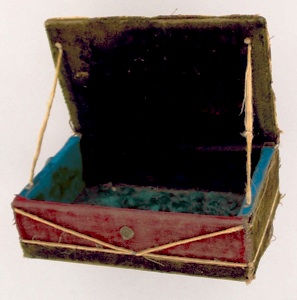
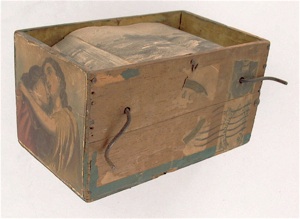
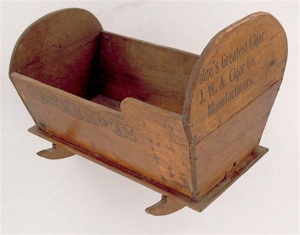
So-called ‘tramp art’ involved layers of notched cigar box wood glued to cigar boxes. These pieces were
typically made by home woodworkers or prisoners, not hoboes. 1850 - 1950. This twin pyramid pedestal was built on a nailed wood 50/13 cigar box honoring the Green Bay, Wisconsin, baseball team around 1890. SOLD
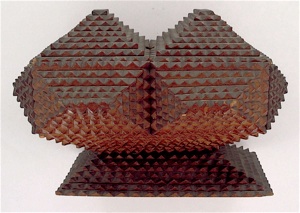
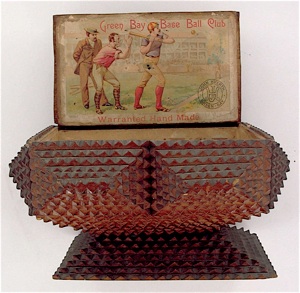
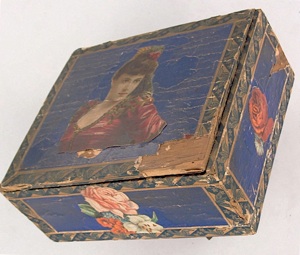
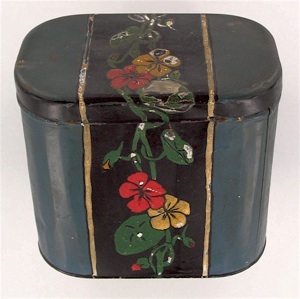
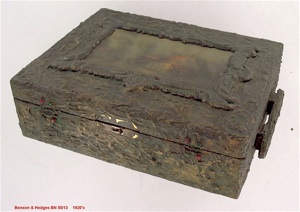
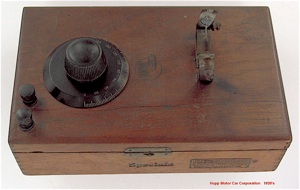
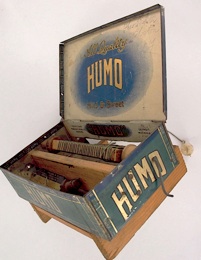
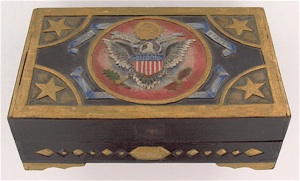
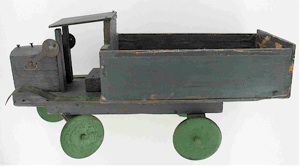
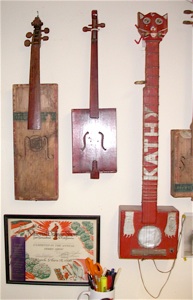
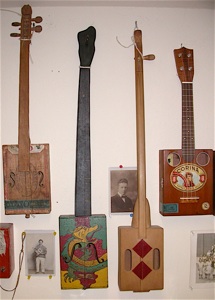
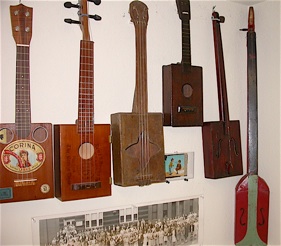
The postcard version (top left) is more rare than the trade card (center) of the same image. Equally rare is the right hand trade card of a solo boy. The 4 cards are not to scale; the two trade card are smaller than the post cards by one-third.
The eight boy band playing cigar box instruments (below) is the most rare image, here on an post card.
[9789] [9791] [not in NCM]
[9790]
Not many booklets are available about cigar box craft. The one on the left is filled with detailed plans for furnishing a doll house with furniture made from cigar boxes. The other builds tableaus in them.
A similar booklet in German explains the art and techniques of pasting bands on objects.
[9785] [9786]
Well designed cigar box chest of drawers based on late 1930’s WHITE OWL boxes. Not part of our collection but displayed so visitors can see what an attractive cigar box drawer set looks like. Most are nowhere near this nice. Photo taken in 1999 by Jane S. Cieply of Hypoint American Antiques & Folk Art, Barrington, Illinois.
To have collector value, bands
must be bright red, not pink .
The chest and jug above are not in the NCM collection.
Empty cigar boxes didn’t have to be messed with to become useful. “Eccentric juggler” Mathieu balances nine empties in this c1900 publicity photo.
19th and 20th century jugglers frequently incorporated cigar boxes into their act because they were light, strong and uniform. At least two different booklets were written instructing would-be jugglers various routines involving cigar boxes.
[8926]
cover of
cigar box
juggling book
temporarily
not available
Painted
I must confess to a bias against painting cigar boxes because I fear that an historically important box would get obliterated. But I fell in love with
“Cigar Smokin’...... Beer Swillin’... Pistol Packin’.... Barbie......” which beautifully enhances a HUDSON’S Golden Palmas boite nature box, otherwise valueless to a collector. It’s the only cigar box kept in my front room with other paintings, prints and sculpture. The striking design was painted in 1999 by contemporary artist Susan J. Rawles. Purchased from the artist on ebay.
Painting and decorating cigar boxes has been popular for nearly two centuries.
[9894]

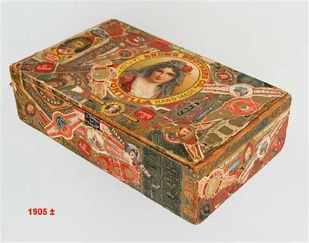
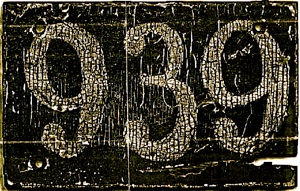
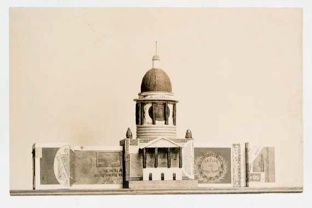
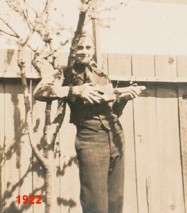
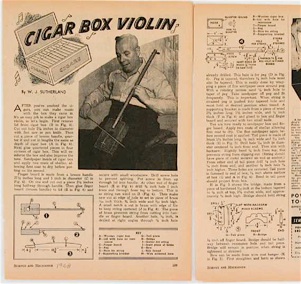

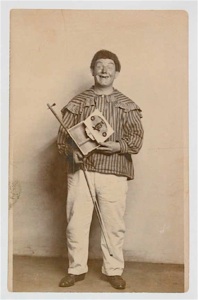
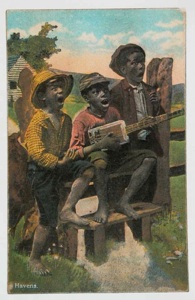


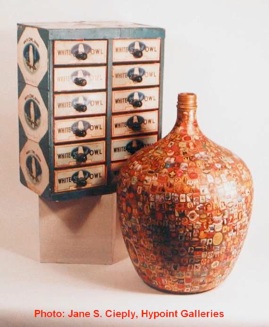
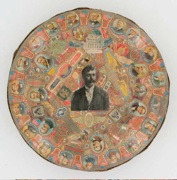
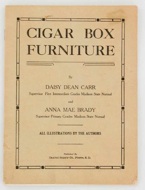



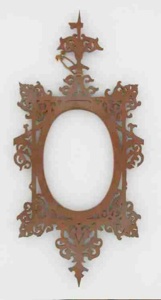
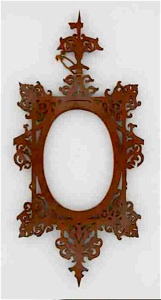
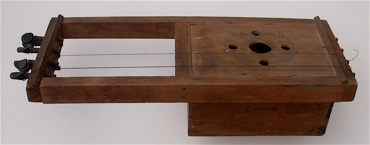

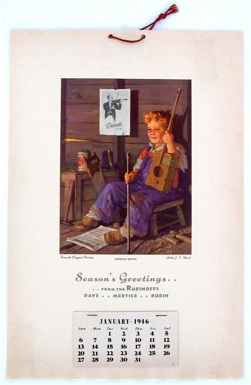
Did “real bands” use cigar box instruments?
Photos and instruments above, right, and below are
not in the NCM collection
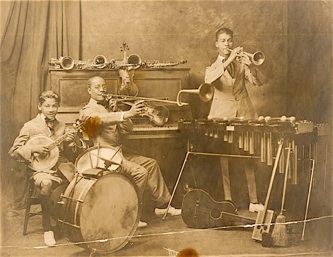
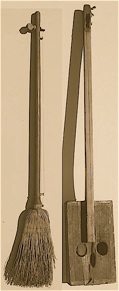
Other musicians pictures found on the web
Unidentified Southern young lady (above right). Unidentified mixed
instrument band (bottom left). Vaudevillian Lee Morgan, 1921 (bottom right)
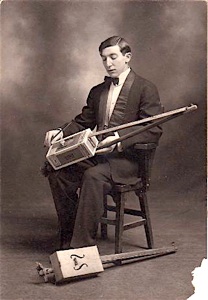
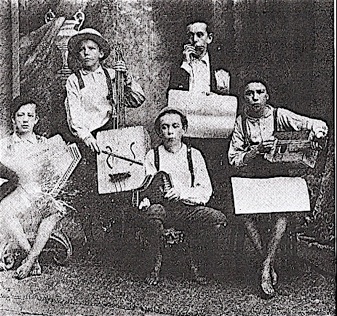
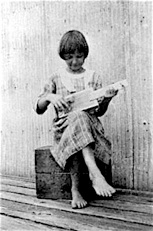

Made from boxes
[11685] No longer in the NCM.
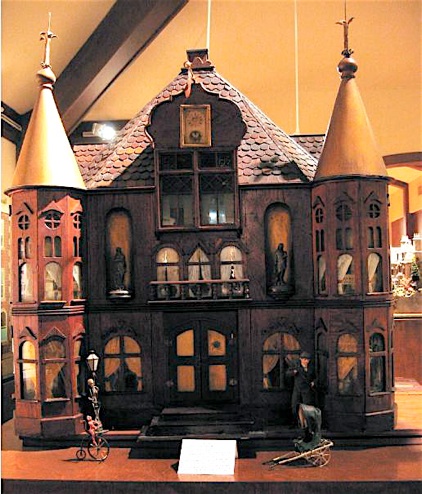
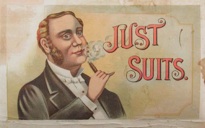
Keith Olivares’s creations
